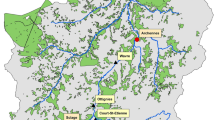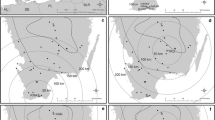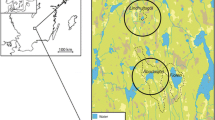Abstract
The need for quantification of land cover from pollen data has led to the development of a Landscape Reconstruction Algorithm (LRA). The LRA includes several models of which the REVEALS model estimates regional vegetation abundance using pollen assemblages from large sites (lakes or bogs). In this paper we explore the effects of selection and number of pollen samples, and choice of pollen productivity estimates on the REVEALS results. The effect of the size of vegetation surveys is also tested. The results suggest that the differences between two sizes of vegetation surveys have little effect on the model validation. The “characteristic radius” of regional vegetation in southern Sweden was estimated as 200 km. However, the vegetation composition in a 100 × 100 km2 square matches well with that estimated by REVEALS. Whether 25, 20 (outliers excluded) or 4 pollen samples are used does not change the REVEALS reconstructions much although the error estimates are larger when outliers are included, and very large when only four samples are used. Therefore validation of the REVEALS model and REVEALS reconstructions of past vegetation can be performed using a limited number of pollen samples, although with caution. The use of many pollen samples from multiple sites is always better whenever possible. REVEALS reconstructions are closer to the actual vegetation when the Danish Pollen Productivity Estimates (PPEs) are used instead of the Swedish PPEs for Cereals, Rumex acetosa/acetosella, Plantago lanceolata and Calluna, indicating that the Danish PPEs are more reliable than the Swedish ones for those taxa. It is recommended to test more than one set of PPEs in validation and applications of the REVEALS model for a better evaluation of the results.










Similar content being viewed by others
References
Berglund BE, Malmer N, Persson T (1991) Landscape-ecological aspects of long-term changes in the Ystad area. In: Berglund BE (ed) The cultural landscape during 6,000 years in southern Sweden, vol 41. The Ystad Project, Ecological Bulletins, pp 405–424
Berglund BE, Lagerås P, Regnéll J (2002) Odlingslandskapets historia i Sydsverige. In: Berglund BE, Börjesson K (eds) Markens minnen. Landskap och odlingshistoria på Småländska Höglandet under 6000 år. Riksantikvarieämbetet, pp 150–174
Beug HJ (2004) Leitfaden der Pollenbestimmung für Mitteleuropa und angrenzende Gebiete. Pfeil, Munich
Broström A (2002) Estimating source area of pollen and pollen productivity in the cultural landscapes of southern Sweden––developing a palynological tool for quantifying past plant cover. Lundqua thesis 46. Lund University, Lund
Broström A, Gaillard MJ, Ihse M, Odgaard B (1998) Pollen landscape relationships in modern analogues of ancient cultural landscapes in southern Sweden––a first steptowards quantification of vegetation openness in the past. Veget Hist Archaeobot 7:189–201
Broström A, Sugita S, Gaillard MJ (2004) Pollen productivity estimates for the reconstruction of past vegetation cover in the cultural landscape of southern Sweden. Holocene 14:368–381
Broström A, Sugita S, Gaillard MJ, Pilesjö P (2005) Estimating the spatial scale of pollen dispersal in the cultural landscape of southern Sweden. Holocene 15:252–262
Broström A, Nielsen AB, Gaillard MJ, Mazier F, Hjelle K, Binney H, Bunting JM, Fyfe R, Meltsov, Poska A, Räsänen S, Soepboer W, von Stedingk H, Sugita S, Suutari H (2008) Pollen productivity estimates––the key to quantitative vegetation and landscape reconstructions. Veget Hist Archaeobot. doi:10.1007/s00334-008-0148-8
Brovkin V, Ganopolski A, Claussen M, Kubatzki C, Petoukhov V (1999) Modelling climate response to historical land cover change. Global Ecol Biogeogr 8:509–517
De Jong R, Broström A, Gaillard MJ, Hellman S, Sugita S (2007) Late Holocene vegetation, land-use and land-cover changes in Halland, south-west Sweden; a quantitative reconstruction using the REVEALS model. In: de Jong R Stormy records from peat bogs in south–west Sweden–implications for regional climatic variability and vegetation changes during the past 6,500 years. Lundqua Thesis 58, Lund University, 37 pp
Engberg A (2002) Produktspecifikation av Svenska CORINE Marktäckedata, Version 2.0. Lantmäteriet SCMD-0001, Gävle
Faegri K, Iversen J (1989) Textbook of Pollen Analysis IV. Wiley, Chichester
Gaillard MJ (2000) Development of the cultural landscape. In: Sandgren P (ed) Environmenta changes in Fennoscandia during the Late Quaternary, vol 37, Lundqua Report, pp 69–82
Gaillard MJ (2007) Pollen Methods and Studies - Archaeological applications. In: Elias SA (ed) Encyclopedia of Quaternary Science 3, Elsevier, pp 2575–2595
Gaillard MJ, Birks HJB, Emanuelsson U, Berglund BE (1992) Modern pollen/land-use relationships as an aid in the reconstruction of past land-uses and cultural landscapes: an example from south Sweden. Veget Hist Archaeobot 1:3–17
Gaillard MJ, Birks HJB, Emanuelsson U, Karlsson S, Lagerås P, Olausson D (1994) Application of modern pollen land-use relationships to the interpretation of pollen diagrams––reconstructions of land-use history in South Sweden, 3000-0 BP. Rev Palaeobot Palynol 82:47–73
Gaillard MJ, Birks HJB, Ihse M, Runborg S (1998) Pollen/landscape calibrations based on modern pollen assemblages from surface-sediment samples and landscape mapping––a pilot study in South Sweden. In: Gaillard MJ, Berglund BE, Frenzel B, Huckriede U (eds) Quantification of land surfaces cleared of forests during the Holocene. Palaeoklimaforschung/Palaeoclimate Research 27, Fischer, Stuttgart, pp 31–52
Gaillard MJ, Sugita S, Broström A, Eklöf M, Pilesjö P (2000) Long term land-cover changes on regional to global scales inferred from fossil pollen––how to meet the challenges of climate research? PAGES Newsl 8:30–32
Goldewijk K (2000) A historical database for integrated environmental assessments: HYDE, vol 81, issue 48, AGU Fall Meeting, Eos, Transitions, American Geophysical Union pp 268
Hellman S (2005) Quantitative reconstruction of past cultural landscapes in southern Sweden, 3000–0 BP using empirical data, models and simulations. Environ Sci Sect Bull 3:45–82
Hellman S, Gaillard MJ, Broström A, Sugita S (2008) The REVEALS model, a new tool to estimate past regional plant abundance from data in large lakes: validation in southern Sweden. J Quatern Sci 23:21–42
Hjelle KL (1998) Herb pollen representation in surface moss samples from mown meadows and pastures in western Norway. Veget Hist Archaeobot 7:79–96
IPCC (ed) (2007) Climate change 2007: the physical science basis. Contribution of working group I to the fourth assessment Report of the intergovernmental panel on climate change
Nielsen AB (2004) Modelling pollen sedimentation in Danish lakes around a.d. 1800––an attempt to validate the POLLSCAPE model. J Biogeogr 31:1693–1709
Parsons RW, Prentice IC (1981) Statistical approaches to R-values and the pollen-vegetation relationship. Rev Palaeobot Palynol 32:127–152
Prentice IC (1985) Pollen representation, source area and basin size: toward a unified theory of pollen analysis. Quatern Res 23:78–86
Prentice IC (1988) Records of vegetation in time and space: the principles of pollen analysis. In: Huntley B, Webb T (eds) Vegetation history, Handbook of vegetation science. Kluwer, Dordrecht, pp 17–42
Prentice IC, Parsons RW (1983) Maximum likelihood linear calibration of pollen spectra in terms of forest composition. Biometrics 39:1051–1057
Ramankutty N, Foley J, Olejniczak N (2000) Changes in global croplands during the 20th century, vol 48, AGU Fall Meeting 2000, Eos, Transactions, American Geophysical Union 81, pp 1–268
Statistics Sweden (2002) Agricultural yearbook. Statistics Sweden, Stockholm
Sugita S (1993) A model of pollen source area for an entire lake surface. Quatern Res 39:239–244
Sugita S (1994) Pollen representation of vegetation in quaternary sediments––theory and method in patchy vegetation. J Ecol 82:881–897
Sugita S (2007a) Theory of quantitative reconstruction of vegetation. I. Pollen from large sites REVEALS regional vegetation. Holocene 17:229–241
Sugita S (2007b) Theory of quantitative reconstruction of vegetation. II. All you need is LOVE. Holocene 17:243–257
Sugita S, Gaillard MJ, Broström A (1999) Landscape openness and pollen records: a simulation approach. Holocene 9:409–421
Sugita S, Gaillard MJ, Hellman S, Broström A (2008) Model-based reconstruction of vegetation and landscape using fossil pollen. Proceedings of the 35th CAA (computer applications and quantitative methods in Archaeology) conference, Berlin, April 2007 (in press)
Acknowledgments
The financial support of VR (Vetenskapsrådet, Swedish Research Council) and NorFA (Nordic Academy of Advanced Studies) is gratefully acknowledged. This paper is a contribution to the POLLANDCAL (POLlen-LANDscape CALibration) network sponsored by NorFA and co-ordinated by M.-J. Gaillard (network website: http://www.geog.ucl.ac.uk/ecrc/pollandcal/). We are grateful to all POLLANDCAL members for useful and inspiring discussions during the numerous network workshops held between 2001 and 2005. We also thank Ralph Fyfe for carefully checking the English language and Florence Mazier for improvement of earlier versions of Figs. 1–3, 6 and 8. Finally, we are very grateful to Thomas Giesecke and an anonymous reviewer for their valuable comments on the manuscript and suggestions to improvements.
Author information
Authors and Affiliations
Corresponding author
Additional information
Communicated by J. Dearing.
Rights and permissions
About this article
Cite this article
Hellman, S.E.V., Gaillard, Mj., Broström, A. et al. Effects of the sampling design and selection of parameter values on pollen-based quantitative reconstructions of regional vegetation: a case study in southern Sweden using the REVEALS model. Veget Hist Archaeobot 17, 445–459 (2008). https://doi.org/10.1007/s00334-008-0149-7
Received:
Accepted:
Published:
Issue Date:
DOI: https://doi.org/10.1007/s00334-008-0149-7




